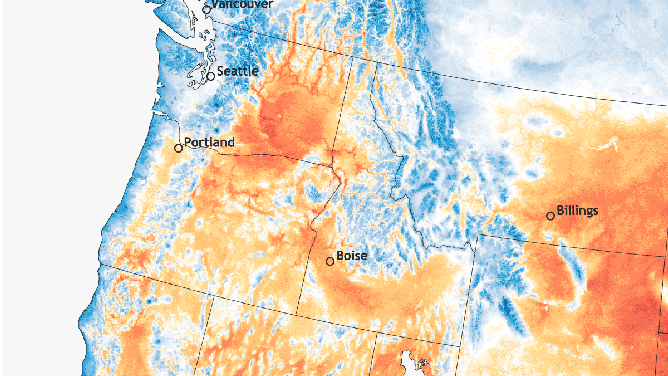Historic heat wave killed hundreds 2 years ago as it baked Northwest in rare 110-plus degree heat
The intense subsidence from one of the strongest summertime ridges measured in history, combined with the maximum solar heating from the calendar near the summer solstice, and parched soils from a recent drought, brought temperatures far beyond anything ever experienced in the region.
2 year anniversary of historic Northwest heat wave.
On June 26-29, 2021, the Pacific Northwest and southwestern B.C. reached tripe-digit temperatures far beyond what the region had experienced before in recorded weather history.
SEATTLE -- Two years ago this week, the Pacific Northwest and much of Canada's British Columbia endured a heat wave that the region had never experienced in its recorded history, leaving hundreds dead as rare triple-digit heat smashed hundreds of daily records and set dozens of all-time heat records, including Canada's national heat record and Washington's state record.
The heat began on June 26, 2021, as an intense storm over the Gulf of Alaska, creating a supercharged ridge of high pressure downstream parked over southern British Columbia. The intense subsidence from one of the strongest summertime ridges measured in history, combined with the maximum solar heating from the calendar near the summer solstice and parched soils from a recent drought, brought temperatures far beyond anything ever experienced in the region.

High temperatures across the western United States on June 23-28, 2021
(NOAA)
"Our analysis showed that the warmth of the air column within the blocking system was in the top 0.01% of all events along the same latitude in the past half a century," said Emily Neal, who recently authored a University of Chicago study on the causes of the extreme heat.
Coastal town bakes at nearly 50 degrees above average
In Seattle, temperatures reached 102 on June 26 -- just the third time Seattle had reached 100 degrees in its recorded weather history and just one degree shy of their all-time record set in 2009.
But it got even hotter on the 27th, breaking that record with a 104-degree reading. Then, the unfathomable happened on June 28 when the temperature reached 108 degrees -- more than 30 degrees above the average high.

In June 2021, all-time temperature records fell in multiple cities in the U.S. and Canada during a "historic and dangerous" heatwave.
(ISS — ECOSTRESS Model / NASA)
It was even hotter in other parts around the normally-temperate region. Highs in some of the Seattle suburbs crossed over 110 degrees. Forks, out on the northern coast, reached 110 degrees - nearly 50 degrees above its average June high of 63 and now has a higher all-time record high than Atlanta, New York and Chicago.
Oregon wasn't spared either, with Portland reaching a blistering 116 degrees after two prior days at 108 and 112 degrees.
British Columbia, where the heat ridge was centered, had some spots eventually push past 110-115 degrees, not only setting city and provincial records but smashing the record for the hottest temperature ever recorded in Canada -- and then breaking the record twice more.

(NASA)
The town of Lytton, B.C., eventually peaked at 121 degrees on June 29, setting the new Canadian heat standard. The old record had been 115 degrees, set in Saskatchewan in 1937.
The heat would abate west of the Cascades on June 29 but shifted into Eastern Washington and Oregon, where widespread temperatures over 110 degrees were observed. Peak among them was a reading in Hanford eventually verified at 120 degrees, breaking the statewide heat record that had been 118 degrees. Oregon tied its state record of 119, reached in two locations east of the Cascades.
HOW TO TELL THE DIFFERENCE BETWEEN HEAT EXHAUSTION AND HEATSTROKE
The heatwave set or tied 128 all-time heat records in Washington and another 116 in Oregon. Over 100 people died in Washington, according to the state Department of Health. A vast majority of Seattle's Puget Sound region where air conditioning was scant. Hundreds more deaths were reported in Oregon and southwestern Canada.
The region is getting a reprieve this year. High temperatures on the anniversary dates are in the seasonal range of 70s and 80s.
